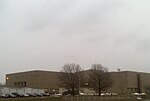The Goddard Space Flight Center (GSFC) is a major NASA space research laboratory located approximately 6.5 miles (10.5 km) northeast of Washington, D.C. in Greenbelt, Maryland, United States. Established on May 1, 1959 as NASA's first space flight center, GSFC employs about 10,000 civil servants and contractors. Named for American rocket propulsion pioneer Robert H. Goddard, it is one of ten major NASA field centers. GSFC is partially within the former Goddard census-designated place; it has a Greenbelt mailing address.GSFC is the largest combined organization of scientists and engineers in the United States dedicated to increasing knowledge of the Earth, the Solar System, and the Universe via observations from space. GSFC is a major US laboratory for developing and operating uncrewed scientific spacecraft. GSFC conducts scientific investigation, development, manufacturing and operation of space systems, and development of related technologies. Goddard scientists can develop and support a mission, and Goddard engineers and technicians can design and build the spacecraft for that mission. Goddard scientist John C. Mather shared the 2006 Nobel Prize in Physics for his work on COBE.
GSFC also operates two spaceflight tracking and data acquisition networks (the Space Network and the Near Earth Network), develops and maintains advanced space and Earth science data information systems, and develops satellite systems for the National Oceanic and Atmospheric Administration (NOAA).
GSFC manages operations for many NASA and international missions including the James Webb Space Telescope (JWST) and Hubble Space Telescope (HST), the Explorers Program, the Discovery Program, the Earth Observing System (EOS), INTEGRAL, MAVEN, OSIRIS-REx, the Solar and Heliospheric Observatory (SOHO), the Solar Dynamics Observatory (SDO), Tracking and Data Relay Satellite System (TDRS), Fermi, and Swift. Past missions managed by GSFC include the Rossi X-ray Timing Explorer (RXTE), Compton Gamma Ray Observatory, SMM, COBE, IUE, and ROSAT.








